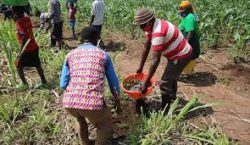The Alliance for a Green Revolution in Africa (AGRA) has predicted a drier than usual season for the October-December period for much of the East African region.
AGRA seeks to transform African agriculture from subsistence to strong business that improves the livelihoods of the continent’s farmers.
The Ministry of Agriculture has encouraged farmers in parts of Rwanda most likely to be affected to take appropriate measures to harvest enough rainwater for irrigation in case of need.
According to the Ministry, depending on present seasonal forecasts for the months of September to December 2021, in parts of the Southern Province and the districts of Bugesera, Kirehe, and Ngoma in the Eastern Province it is expected that rainfall will decrease compared to the amounts usually received in agricultural season A.
Farmers in these regions of the country are encouraged to cultivate plants that grow faster and also put much emphasis on tapping and storing rainwater which will be used when the rains are not enough, reads part of a related Ministry advisory to farmers during the ongoing agricultural season A.
Season A starts in September every year with the planting of crops like maize, beans, cassava, Irish potatoes, and ends in February.
Farmers who talked to The New Times agree that the collection and storage of rain, rather than allowing it to run off, if well done, could help but they are also concerned because harvesting rainwater is no easy thing.
Kellen Busingye, a member of a maize-growing cooperative in Nyagatare District on Monday, October 11, said they can only try to plan for it in the near future.
She said: “The rains have started but it [hervesting rainwater] is very difficult and we haven’t done it before. Doing something you have not budgeted for is not easy. You cannot just implement it there and then. Tapping rainwater is expensive; you need resources for that. One has to plan and prepare for such things. We shall, perhaps, plan for it another time.”
Busingye said the 38 farmers in her cooperative have, all together, up to 30 hectares now ready for maize planting.
In Ruhango District, Leonard Ndagijimana, a member of a cooperative of 25 farmers with up to 80 hectares in “scattered” areas said they mainly cultivate cassava but they also do other food crops especially beans, onions, and some fruits said unless there was some kind of special support from the government, harvesting rainwater will be a tough call.
“We are now waiting for the rains,” he said, adding: “But we don’t have any special capacity for harvesting rainwater and it is not easy for us unless there is support.”
To help farmers deal with challenges related to the predicted drier than usual weather forecast, the government considered a small scale irrigation subsidy as one of the opportunities for farmers to tap into.
Eugene Kwibuka, Spokesperson of the Ministry of Agriculture, explained how, for example, more than Rwf1 billion was earmarked for irrigation subsidies in priority districts in the current fiscal year.
He noted that: “Considering the current rain challenges, farmers can apply for the subsidy.
“It’s for small scale irrigation technology; if you want to buy a small water pump or water pumping engine, and so on. Farmers need to tap into these opportunities.”
The small scale irrigation technology (SSIT) programme is being run in Gatisbo, Kayonza, Kirehe, Bugesera, Ngoma, Nyagatare, Rwamagana, Huye, Gasabo, Kicukiro, and Nyarugenge Districts.
It is providing a government subsidy to individual farmers, groups of farmers or cooperatives with consolidated land between 0.5 and 10 hectares under agricultural use.
AGRA’s Food Security Monitor provides an overview assessment of the food security outlook in countries in East, West and Southern Africa, taking into account the movement of prices of main food staples and government interventions that impact on domestic and regional food trade alongside the impact of forecast weather changes and environmental conditions on food security.
According to AGRA’s September Food Security monitor, the dry seasonal forecast has significant implications for the new cropping season.
“Seasonal harvests and supplies would be adversely affected, impacting food prices and food and nutrition security.”
Agricultural commodities price
Maize prices in Ethiopia, Kenya, and Uganda remain on an upward trend. Rwanda and South Sudan prices show mixed results, while selected markets in Tanzania show favourable maize prices. Poor seasonal and erratic rainfalls, floods, and desert locusts affected crop and animal production in Ethiopia, Kenya and Uganda, and adversely affected price movements.
“Conflicts and insecurity in certain parts of the region and Covid-19 related restrictions have impacted trade flows, driving up food prices,” reads part of AGRA’s Food Security Monitor.
“The forecast for Rwanda looks bleak, while Tanzania is expected to maintain improvement in prices in certain markets but deterioration in others.”

